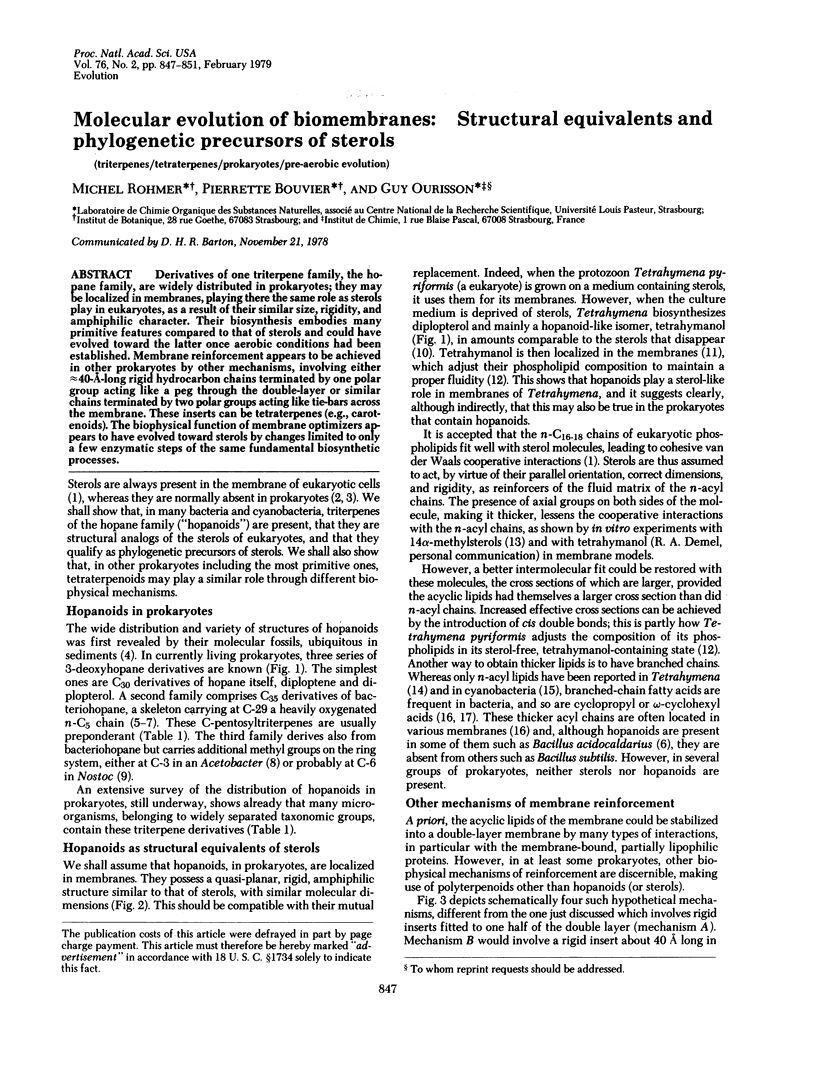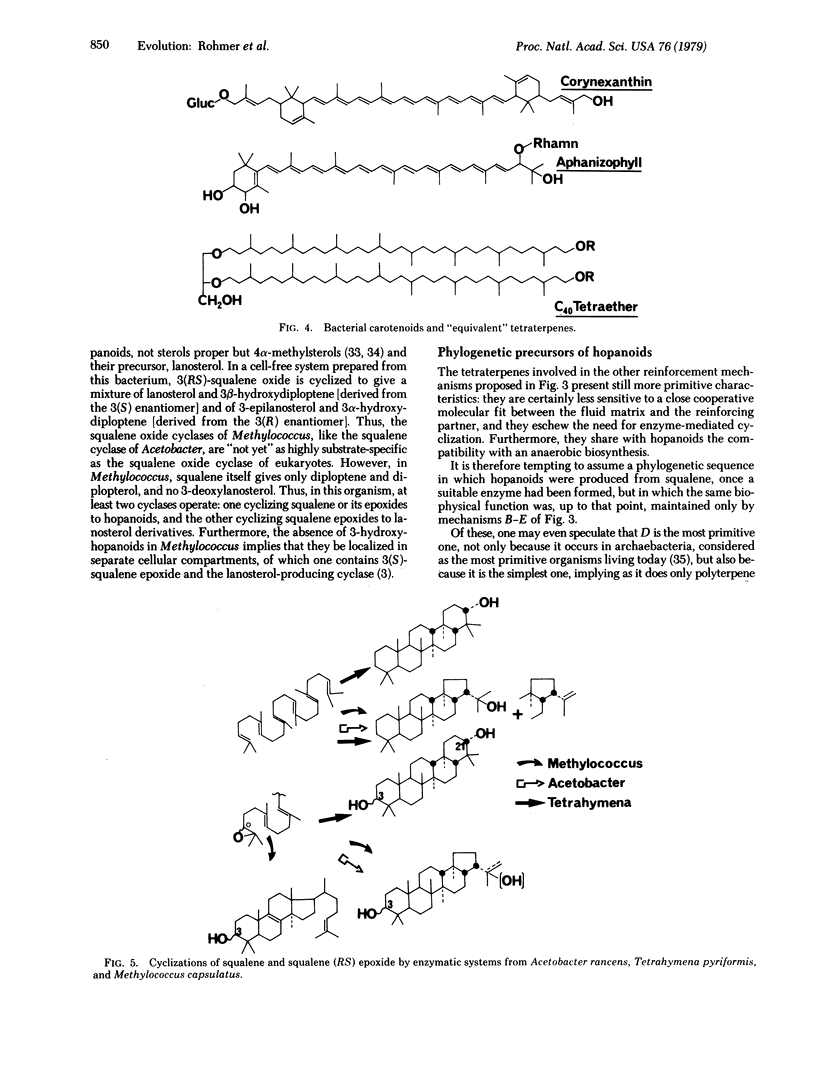Abstract
Derivatives of one triterpene family, the hopane family, are widely distributed in prokaryotes; they may be localized in membranes, playing there the same role as sterols play in eukaryotes, as a result of their similar size, rigidity, and amphiphilic character. Their biosynthesis embodies many primitive features compared to that of sterols and could have evolved toward the latter once aerobic conditions had been established. Membrane reinforcement appears to be achieved in other prokaryotes by other mechanisms, involving either approximately 40-A-long rigid hydrocarbon chains terminated by one polar group acting like a peg through the double-layer or similar chains terminated by two polar groups acting like tie-bars across the membrane. These inserts can be tetraterpenes (e.g., carotenoids). The biophysical function of membrane optimizers appears to have evolved toward sterols by changes limited to only a few enzymatic steps of the same fundamental biosynthetic processes.
Full text
PDF




Images in this article
Selected References
These references are in PubMed. This may not be the complete list of references from this article.
- Anding C., Rohmer M., Ourisson G. Letter: Nonspecific biosynthesis of hopane triterpenes in a cell-free system from Acetobacter rancens. J Am Chem Soc. 1976 Mar 3;98(5):1274–1275. doi: 10.1021/ja00421a045. [DOI] [PubMed] [Google Scholar]
- Anwar M., Khan T. H., Prebble J., Zagalsky P. F. Membrane-bound carotenoid in Micrococcus luteus protects naphthoquinone from photodynamic action. Nature. 1977 Dec 8;270(5637):538–540. doi: 10.1038/270538a0. [DOI] [PubMed] [Google Scholar]
- Barton D. H., Jarman T. R., Watson K. C., Widdowson D. A., Boar R. B., Damps K. Investigations on the biosynthesis of steroids and terpenoids. Part XII. Biosynthesis of 3beta-hydroxy-triterpenoids and -steroids from (3S)-2,3-epoxy-2,3-dihydrosqualene. J Chem Soc Perkin 1. 1975;(12):1134–1138. doi: 10.1039/p19750001134. [DOI] [PubMed] [Google Scholar]
- Bird C. W., Lynch J. M., Pirt F. J., Reid W. W. Steroids and squalene in Methylococcus capsulatus grown on methane. Nature. 1971 Apr 16;230(5294):473–474. doi: 10.1038/230473a0. [DOI] [PubMed] [Google Scholar]
- Bouvier P., Rohmer M., Benveniste P., Ourisson G. Delta8(14)-steroids in the bacterium Methylococcus capsulatus. Biochem J. 1976 Nov;159(2):267–271. doi: 10.1042/bj1590267. [DOI] [PMC free article] [PubMed] [Google Scholar]
- Brandt R. D., Benveniste P. Isolation and identification of sterols from subcellular fractions of bean leaves (Phaseolus vulgaris). Biochim Biophys Acta. 1972 Sep 1;282(1):85–92. doi: 10.1016/0005-2736(72)90313-6. [DOI] [PubMed] [Google Scholar]
- Conner R. L., Landrey J. R., Burns C. H., Mallory F. B. Cholesterol inhibition of pentacyclic triterpenoid biosynthesis in Tetrahymena pyriformis. J Protozool. 1968 Aug;15(3):600–605. doi: 10.1111/j.1550-7408.1968.tb02178.x. [DOI] [PubMed] [Google Scholar]
- De Rosa M., Gambacorta A., Minale L., Bu'lock J. D. The formation of -cyclohexyl-fatty acids from shikimate in an acidophilic thermophilic bacillus. A new biosynthetic pathway. Biochem J. 1972 Jul;128(4):751–754. doi: 10.1042/bj1280751. [DOI] [PMC free article] [PubMed] [Google Scholar]
- Demel R. A., De Kruyff B. The function of sterols in membranes. Biochim Biophys Acta. 1976 Oct 26;457(2):109–132. doi: 10.1016/0304-4157(76)90008-3. [DOI] [PubMed] [Google Scholar]
- Ferguson K. A., Davis F. M., Conner R. L., Landrey J. R., Mallory F. B. Effect of sterol replacement in vivo on the fatty acid composition of Tetrahymena. J Biol Chem. 1975 Sep 10;250(17):6998–7005. [PubMed] [Google Scholar]
- Förster H. J., Biemann K., Haigh W. G., Tattrie N. H., Colvin J. R. The structure of novel C35 pentacyclic terpenes from Acetobacter xylinum. Biochem J. 1973 Sep;135(1):133–143. doi: 10.1042/bj1350133. [DOI] [PMC free article] [PubMed] [Google Scholar]
- Huang L., Haug A. Regulation of membrane lipid fluidity in Acholeplasma laidlawii: effect of carotenoid pigment content. Biochim Biophys Acta. 1974 Jun 29;352(3):361–370. doi: 10.1016/0005-2736(74)90228-4. [DOI] [PubMed] [Google Scholar]
- Kaneda T. Fatty acids of the genus Bacillus: an example of branched-chain preference. Bacteriol Rev. 1977 Jun;41(2):391–418. doi: 10.1128/br.41.2.391-418.1977. [DOI] [PMC free article] [PubMed] [Google Scholar]
- Kushwaha S. C., Kates M., Martin W. G. Characterization and composition of the purple and red membrane from Halobacterium cutirubrum;. Can J Biochem. 1975 Mar;53(3):284–292. doi: 10.1139/o75-040. [DOI] [PubMed] [Google Scholar]
- LEVIN E. Y., BLOCH K. ABSENCE OF STEROLS IN BLUE-GREEN ALGAE. Nature. 1964 Apr 4;202:90–91. doi: 10.1038/202090a0. [DOI] [PubMed] [Google Scholar]
- Langworthy T. A., Mayberry W. R. A 1,2,3,4-tetrahydroxy pentane-substituted pentacyclic triterpene from Bacillus acidocaldarius. Biochim Biophys Acta. 1976 Jun 22;431(3):570–577. doi: 10.1016/0005-2760(76)90221-6. [DOI] [PubMed] [Google Scholar]
- Nes W. R. Role of sterols in membranes. Lipids. 1974 Aug;9(8):596–612. doi: 10.1007/BF02532509. [DOI] [PubMed] [Google Scholar]
- Thirkell D., Hunter M. I. The polar carotenoid fraction from sarcina flava. J Gen Microbiol. 1969 Nov;58(3):293–299. doi: 10.1099/00221287-58-3-293. [DOI] [PubMed] [Google Scholar]
- Thompson G. A., Bambery R. J., Nozawa Y. Further studies of the lipid composition and biochemical properties of Tetrahymena pyriformis membrane systems. Biochemistry. 1971 Nov 23;10(24):4441–4447. doi: 10.1021/bi00800a014. [DOI] [PubMed] [Google Scholar]
- Tsuda Y., Isobe K., Fukushima S., Ageta H., Iwata K. Final clarification of the saturated hydrocarbons derived from hydroxyhopanone, diploptene, zeorin, and dustanin. Tetrahedron Lett. 1967 Jan;1:23–28. doi: 10.1016/s0040-4039(00)90940-7. [DOI] [PubMed] [Google Scholar]
- Woese C. R., Fox G. E. Phylogenetic structure of the prokaryotic domain: the primary kingdoms. Proc Natl Acad Sci U S A. 1977 Nov;74(11):5088–5090. doi: 10.1073/pnas.74.11.5088. [DOI] [PMC free article] [PubMed] [Google Scholar]
- Yamamoto H. Y., Bangham A. D. Carotenoid organization in membranes. Thermal transition and spectral properties of carotenoid-containing liposomes. Biochim Biophys Acta. 1978 Feb 2;507(1):119–127. doi: 10.1016/0005-2736(78)90379-6. [DOI] [PubMed] [Google Scholar]
- Yeagle P. L., Martin R. B., Lala A. K., Lin H. K., Bloch K. Differential effects of cholesterol and lanosterol on artificial membranes. Proc Natl Acad Sci U S A. 1977 Nov;74(11):4924–4926. doi: 10.1073/pnas.74.11.4924. [DOI] [PMC free article] [PubMed] [Google Scholar]
- Zander J. M., Greig J. B., Caspi E. Tetrahymanol biosynthesis. Studies in vitro on squalene cyclization. J Biol Chem. 1970 Mar 25;245(6):1247–1254. [PubMed] [Google Scholar]



